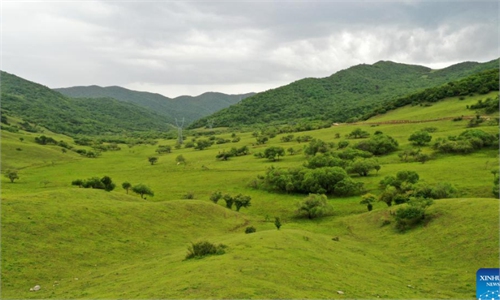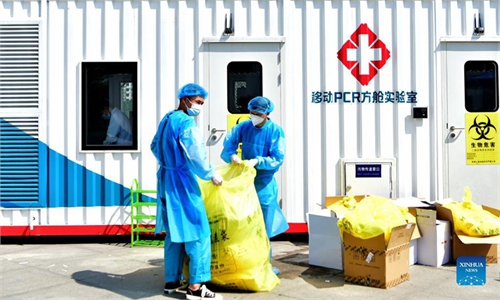Snap the blue: Beijing resident witnesses 10-year steady air quality improvement as nation beats pollution as promised
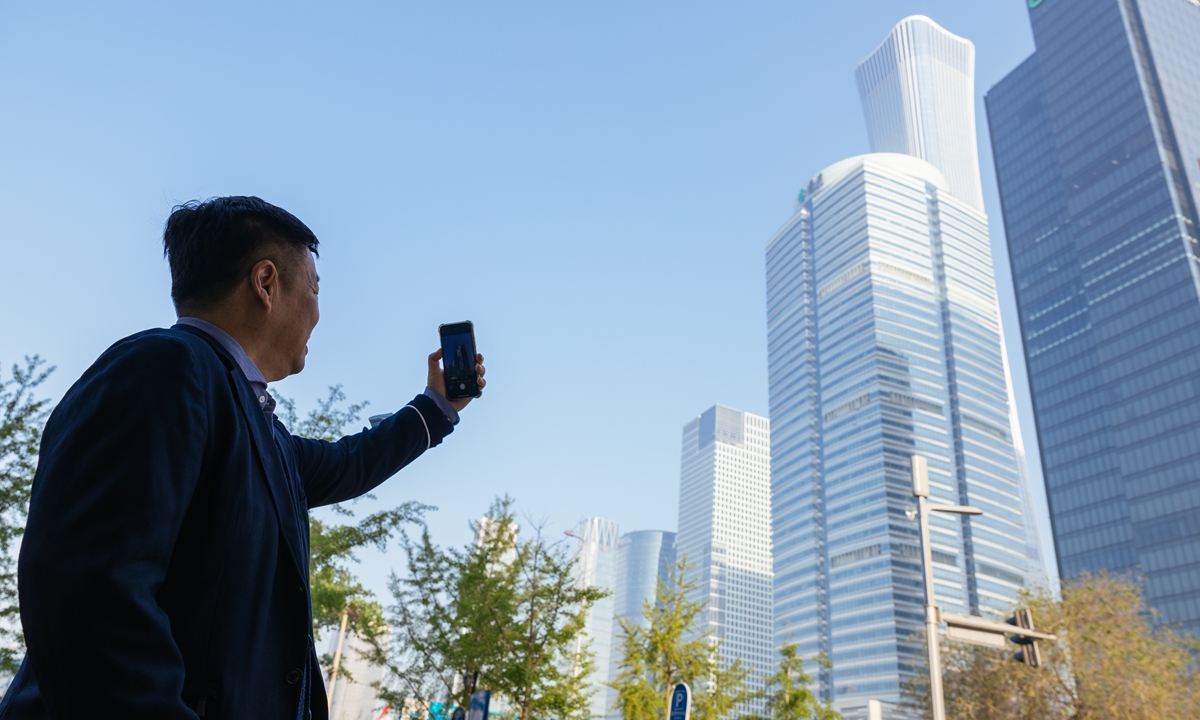
Zou Yi takes a photo in Beijing CBD. Photo: Li Hao/GT
Editor's Note:
Looking back over the last decade, China has witnessed tremendous changes, which could not have been achieved without the hard work of its people.
There are many ways to record the past decade, but the story that, at times, leaves a mark on each person is surely the most vivid. To welcome the 20th National Congress of the Communist Party of China (CPC), the Global Times has launched a series of stories to pay tribute to people from all walks of life who have contributed their wisdom and energy to the realization of the Chinese Dream.
In this installment, a man who has recorded Beijing's CBD quotidian sky in the past decade shared his observations on the improvement of air quality in China's capital, as well as his understanding of the efforts behind the brilliant blue skies.
At the beginning of the scrolls, which shows Beijing's skies in the year 2013, the photos were generally gray, gloomy, and foggy, but gradually, they transitioned to a clearer blue, sometimes crystal clear, showing the steady air quality improvement in northern China.
These are the presentations of Zou's modest yet impactful project in the past decade - he recorded the sky of the capital city with his phone every day from the same position, a direct and objective way to witness the change, which received much attention domestically and overseas.
The 18th CPC National Congress in 2012 was a real turning point, as this significant meeting was the catalyst behind the Beautiful China initiative and the pursuit of blue skies and clean water and soil.
Thanks to the country's campaign "beat air pollution," the average density of major pollutant PM2.5 in Beijing went down to 33 micrograms per cubic meter in 2021 from 89.5 micrograms per cubic meter in 2013, according to the Ministry of Ecology and Environment.
From Day 1 to Day 3,400
Early morning on the day that would mark the start of his project, Zou walked through the Beijing CBD - his daily routine and a three-kilometer walk.
He was accompanied by his Shiba Inu named Baiyou. They stopped at some places, where Zou would take out his phone to take pictures at certain angles, his canine sidekick waiting patiently in the wings.
After that, on his social media platforms, Zou would share the pictures and videos he had just taken - the busy traffic on the Dawang Road, with the CBD skyscrapers as the backdrop.
The routine has been going for nearly 10 years without fail.
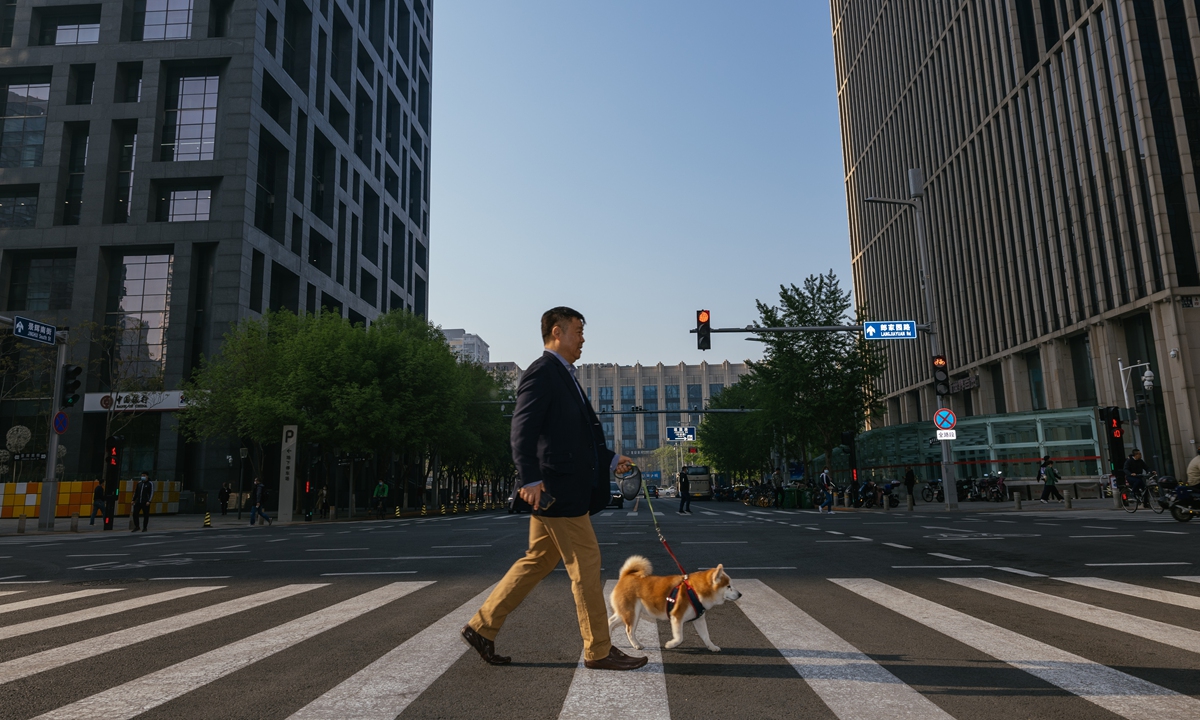
Zou Yi and his dog Baiyou walks in the Beijing CBD. Photo: Li Hao/GT
Zou Yi took his first photo on January 27, 2013.
On that day, the air quality in Beijing was particularly terrible. "Both the media and the public talked about Beijing's heavy air pollution, including me. I like photography and am curious, so I snapped my first sky photo that day with my smartphone," Zou said.
He did the same the next day, and the day after that. After two months of photographing, Zou retouched and merged 64 sky photos in a collage, which greatly shocked him as he saw how polluted the skies were in those past two months.
He then shared the collage on various social media platforms. It stunned many.
Zou then "enlarged" his vision: to take pictures of the sky for a whole year to see if the picture consisting of 365 pieces of sky would be even more shocking.
After a year, he continued - for eight more years.
He, naturally, has the most direct amateur observations ever captured of the changes above the heart of Beijing.
"The air quality in Beijing has hugely improved. The number of blue sky photos gradually surpassed those of gray skies each year; fresh air has replaced air pollution as Beijing's new normal," Zou told the Global Times.
He titled his project "Beijing Air Now," which has since received more than 1.5 billion views on Sina Weibo. He used the photos to promote the public's awareness of air pollution and the environment. He has cooperated with more than 80 academic institutes that have used his pictures as materials for research.
Currently, he is working with a research team in the Chinese Academy of Sciences to develop a smartphone application for smog detection and air quality assessment.
"Taking one photo of the sky every day is a very easy thing for me, but how powerful this small deed could become overwhelmed me," Zou said.
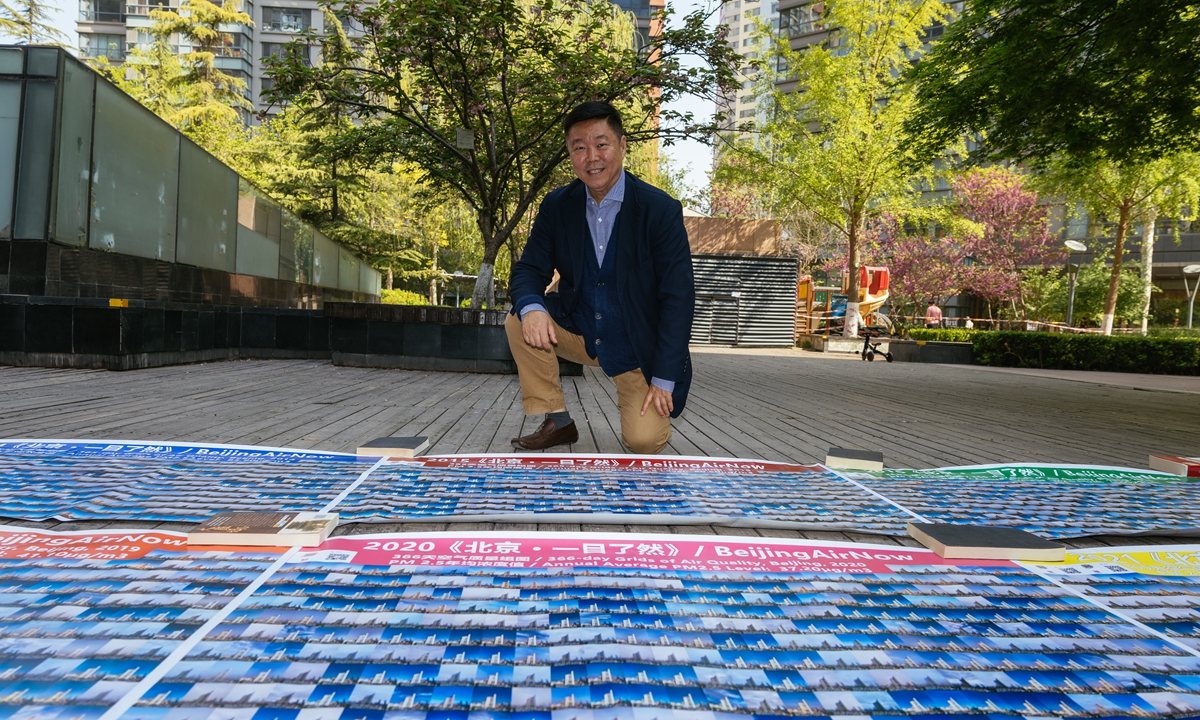
Zou Yi shows his Beijing Air Now scroll. Photo: Li Hao/GT
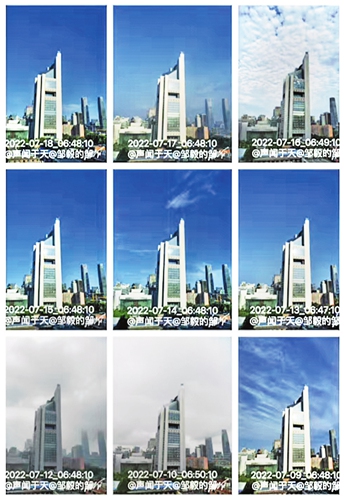
Photos of Beijing's sky taken by Zou Yi from July 9-18, 2022
China's institutional advantage
It took London and Los Angeles more than 50 years to deal with air pollution compared to only a decade for Beijing.
"The developed capitalist countries have limitations in adjustment especially in space and in industry. When the relevant authorities realized the harm of pollution and began to manage and tackle it, it still took a very long time to be actualized," Zou said. "Even worse, they transferred the pollutive factories to developing countries."
"When China became aware of its environmental problems, it took actions to improve, adjusting the energy, transportation, industrial structures, and the urban space. All these adjustments work collectively, and the synergistic effect far exceeds a single adjustment," Zou said.
The battle against air pollution perfectly exemplifies the Chinese administration's determination and action in building a prosperous and beautiful country, which, over the years, has claimed some major stepwise victories thanks to the tough and comprehensive policies.
But the process of beating air pollution in China has seen difficulties, challenges, and growing pains. At times, conserving the environment and ecology comes at a cost to economic benefits and delays development in some regions.
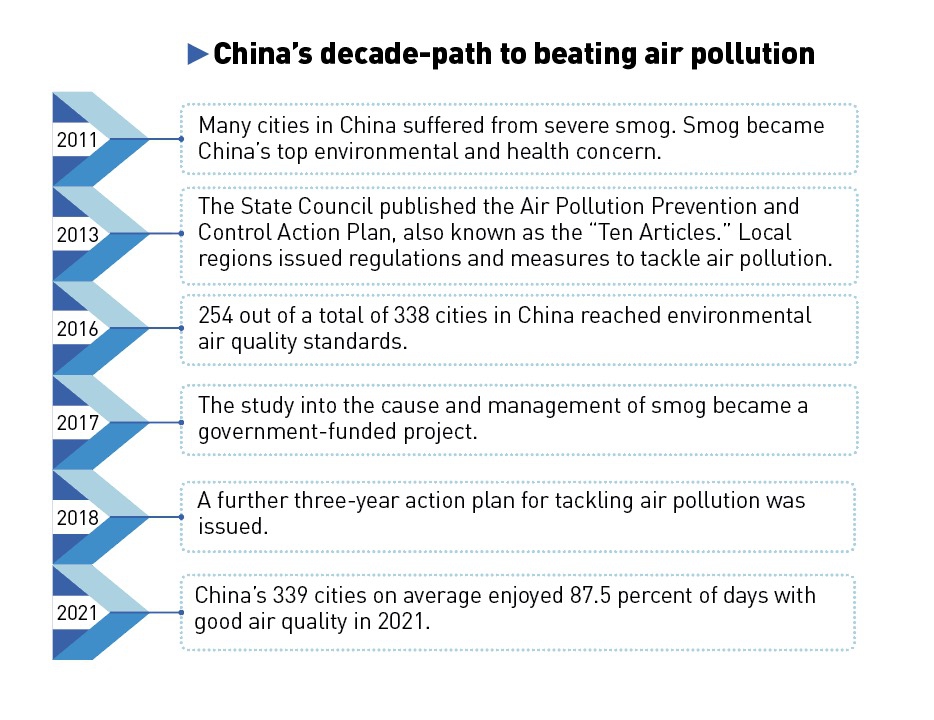
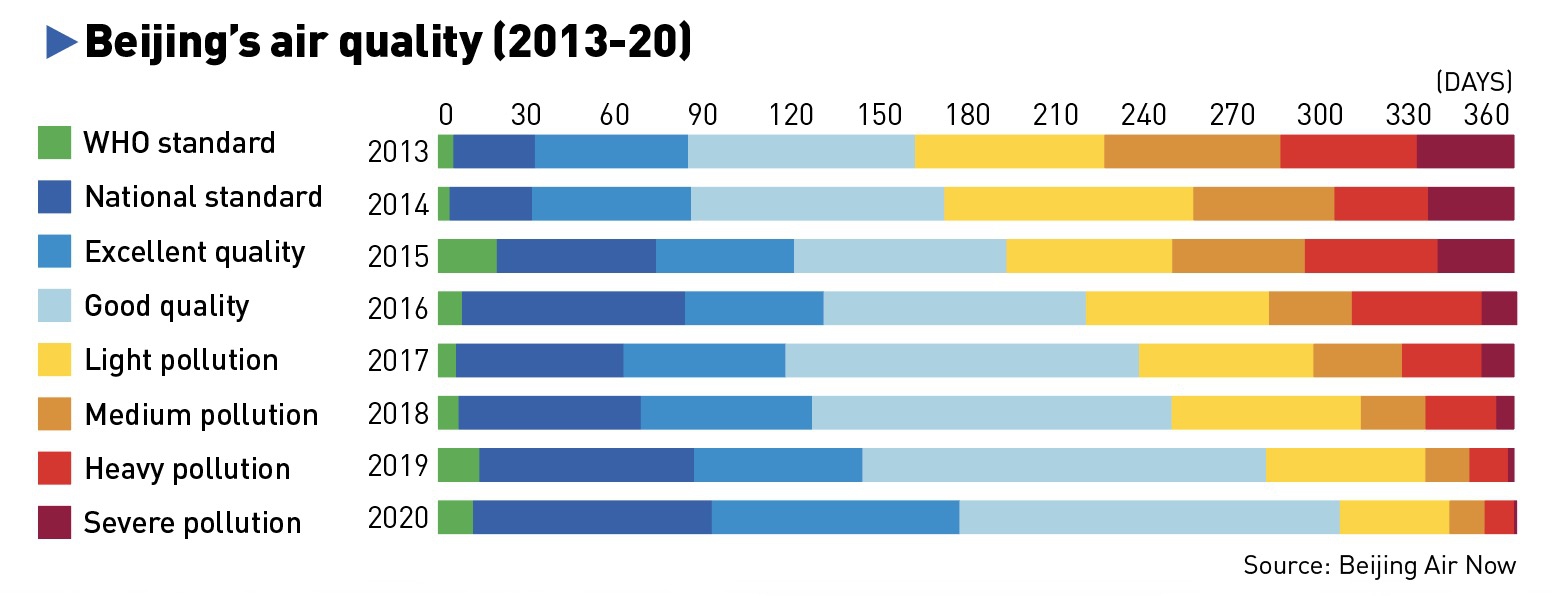
GT
In 2011, many cities in China suffered from severe smogs, which triggered heated discussions and drew the attention of the international community. "Moreover, some cities provided fake data on environment assessment at that time," Zou said.
Monitoring and publishing the air quality index (AQI) was the first step. China promulgated the "Air Pollution Prevention Action Plan" in 2013, which was instructional in tackling air pollution and saw effects soon after.
Winning the battle to defend the blue skies became a major decision and deployment made by the 19th National Congress of the CPC.
In 2020, the percentage of days with good air quality was 87 percent in 337 cities at and above the prefecture level, up by 5.8 percentage points from the 2015 level.
In 2021, Beijing made a breakthrough in its air pollution treatment as the city reached the national air quality standard. The city saw 288 days of good and excellent air quality, 112 days more than it did in 2013. The number of severely polluted days during summer and autumn were eight days, dropping by 86.2 percent compared with 2012, according to Xinhua.
The city's average concentration of PM2.5 was 33 micrograms per cubic meter in 2021, the lowest level since records began in 2013.
Over the years, President Xi Jinping has stressed advancing for ecological civilization on many occasions. "Clear waters and lush mountains are invaluable assets," the frequently quoted words have been a key component of Xi's thoughts on ecological progress, according to the Xinhua News Agency.
"I truly respect the theories on environment protection in China, which have led us to these achievements and in this direction on protecting environment and ecology today," Zou said.
"Now, China has motivated people across the whole country to follow this path. Many people have shift from passively following the requirements to actively taking part in environmental protection because they realized it is beneficial for them in the long term," Zou said.
Seeking higher goals
While seeing achievements in beating air pollution and protecting the environment, China is now aiming wider and further.
Zou, who worked in Africa in 1980s and 1990s, has also witnessed how Chinese companies' awareness on protecting local environment improved.
"China is now paying greater attention in local environments and ecologies while helping other countries in infrastructural development," he said. China introduces its best and most sustainable experiences, technologies, and ideas during the process because the projects are usually long-term.
"Local people will find out sooner or later that China came for win-win cooperation rather than the "colonial plunder" hyped by some Western countries," Zou added.
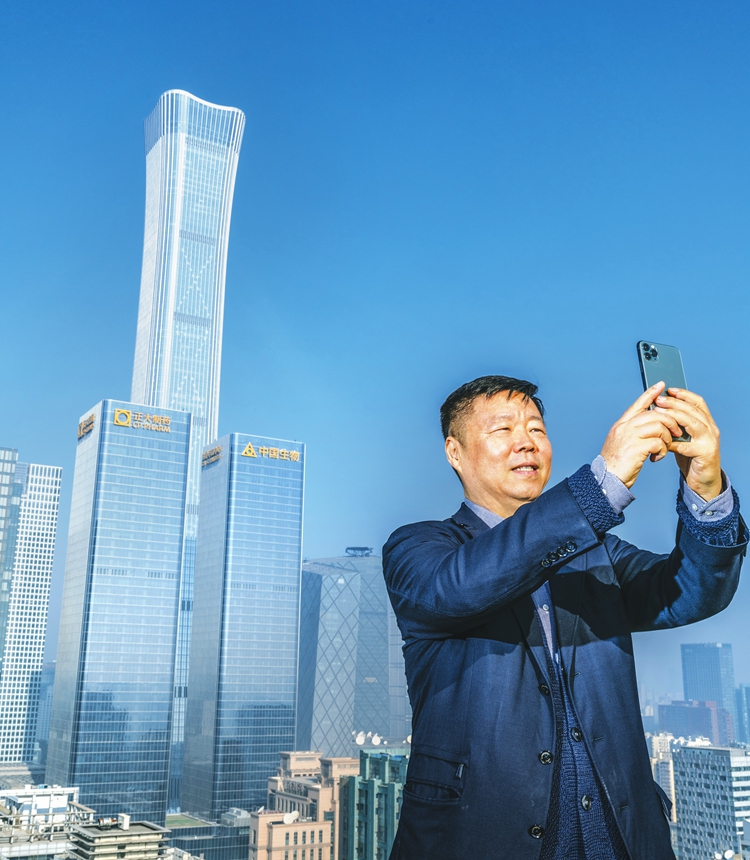
Zou Yi takes a photo in Beijing CBD. Photo: Li Hao/GT
On the day of the interview, Zou's scrolls attracted passersby to linger and observe.
"How do you view today's air quality?" Zou asked a senior citizen casually.
"A bit smoggy I guess," the man said with a grin. On that day, the sky was light blue, bright, and shiny. But the AQI index suggested that the air was slightly polluted in urban Beijing.
"You see, now people can estimate the air quality pretty accurately," Zou told the Global Times. "They have formed an understanding after many years living with air pollution and smog." But the new generation may not have such an ability to tell "how polluted today is."
"Now smog is much rarer and people pay increasingly less attention to air quality every day," Zou said.
When addressing the 75th session of the UN General Assembly in September 2020, President Xi said that China aims to have CO2 emissions peak before 2030 and achieve carbon neutrality before 2060.
At the 76th session of the UN General Assembly in 2021, Xi announced that China would ramp up support for other developing countries to develop green and low-carbon energy, and will not build new coal-fired power projects abroad.
"I want to do something related to the dual carbon goals, but I am still thinking," Zou said.
After 10 years of having a routine of capturing the sky, it might be time for Zou to say farewell to this epic project and welcome a new start.


